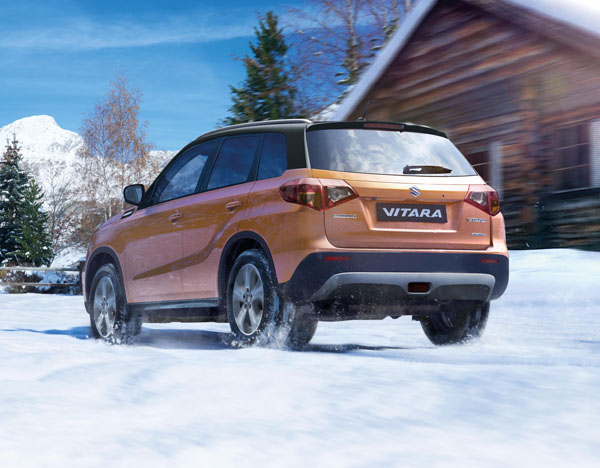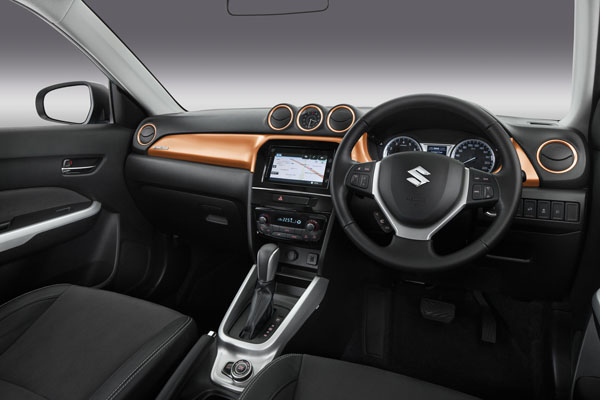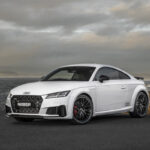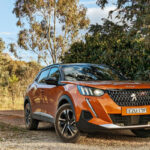
Suzuki still gets it. The company that turned the Swift, an inconsequential small hatchback, into a raging sales success, worn as a good taste badge of honour by males and females of all ages, may have done it again.
Its popular sports utility vehicle, the Vitara, has been given a makeover that blends the best of its solid SUV looks with modern, edgy styling to produce a head-turning yet practical crossover.
The fifth-generation Vitara comes in two-wheel and four-wheel drive in two specification levels – RT-S and RT-X – the former in five-speed manual or six-speed automatic format; the range topper RT-X only in six-speed auto with steering-wheel mounted paddle shifts.
Both are powered by Suzuki’s M16 1.6-litre four-cylinder petrol engine putting out 88 kW of power and 156 Nm of torque. The RT-S manual 2WD comes to market at $21,990, while the RT-X flagship, which adds a panoramic sunroof, suede/leather interior and Suzuki Allgrip 4WD system, among other upgrades, carries a $10,000 premium.
At launch, drive-away pricing is being offered – $22,990 for the manual, with the auto available from just $24,990. The entry-level RT-S two-wheel drive manual was the test vehicle.
STYLING
Suzuki has taken a leaf out of the Mini manual to offer a long shopping list of options, including contrasting roof colours, matching interior panels and unique wheels to attract the individualist car buyer.
Besides the black roof with silver rails, the red test vehicle featured just enough garnish, including grey grille and bumper inserts front and back, plus similar shade wheels. Exterior accessories like black grilles and black alloy wheels, born out of Suzuki’s pre-launch ‘Design and Win a Vitara competition’, can add even more attitude.
All models come standard with satellite navigation, reversing camera, LED daytime running lights, 17-inch alloy wheels, privacy glass and more, while Vitara’s traditional clam shell bonnet has been carried over, so everything’s not all shiny and new.
INTERIOR
Following on from exterior options, buyers can mix and match two-tone body colours with interchangeable accessory panels to create their own unique interior look.
Instrument and controls are simplicity themselves, with speedo and tacho rings, and digital info centre, bringing up fuel status, range and more. The centre console is home to climate control air-conditioning controls, while directly above is an analogue clock – a nice, quality touch usually only found in luxury vehicles.
INFOTAINMENT
The touch screen displays a quadrant of information including audio, sat nav, phone and Bluetooth connectivity. Simple screen switching and control of some of the four offerings is complemented by steering wheel-mounted buttons.
Screen clarity is excellent, with 3-D mapping and a wide-angle view from the reversing camera some of the best around. Audio sound quality is that of a more expensive vehicle too.
ENGINES / TRANSMISSIONS
The new Vitara is powered by the M16 1.6-litre petrol engine. Lower friction and weight savings in the engine and related components are designed to come up with fuel economy and generous power output (88 kW) and torque (165 Nm), both available when most needed – in this case 6000 and 4400 rpm, respectively.
The five-speed manual transmission is fitted with a shift-lever counterweight to produce a smooth, positive action, making for pleasant driving, the six-speed automatic’s wide gear-ratio range allows precise control over gear ratios to help with response at low vehicle speeds.
SAFETY
Standard fitment on every new Vitara is an electronic stability program, hill hold control and rear-view camera; seven airbags including dual front, side and curtain airbags and drivers knee airbag.
Suzuki’s impact absorbing body technology and pedestrian protection impact absorbing structures also add to Vitara’s safety credentials.
DRIVING
While performance far from matches European SUVs, handling of the two-wheel drive test car was easy going with little to take the driver by surprise, neither was it enough to stir his or her blood.
Fuel consumption of the 1.6-litre powered manual vehicle was seven litres per 100 kilometres around town and four on the open road, against the maker’s claim of 5.8 litres per 100 kilometres on the combined urban / highway cycle.
The new Vitara is left behind somewhat by its five-speed manual transmission. Many of today’s manuals are six speed to cash in on fuel economy and performance. The Vitara cries out for a sixth cog.
For a stubby gearshift, the lever has a surprisingly long(ish) throw and requires the full attention of the driver between notches. On the other hand, optimum shifts are suggested on the system information screen directly behind the steering wheel.
The car also suffers from Sunshine State Syndrome. With the windscreen at such a raked angle in bright sunlight, reflection on the instrument panel glass all but completely obscures the speedo and tacho dials.
SUMMING UP
It may have been the fire-engine red paintwork with contrasting black roof and grey bits, but the test car turned quite a few heads, which is a good start for sales in such a congested market. It’s no hot hatch but a well-specced versatile vehicle with competitive pricing. The latest Vitara could well be the new Swift.
AT A GLANCE
MODEL LINE-UP
Suzuki Vitara RT-S manual 2WD $21,990
Suzuki Vitara RT-S automatic 2WD $23,990
Suzuki Vitara RT-X automatic 4WD $31,990
Note: These prices do not include dealer or government charges. Contact your local Suzuki dealer for drive-away prices.
FEATURES
RT-S
Multimedia satellite navigation
7 airbags & ESC
ABS, EBD & BA
Cruise control
Digital climate control
Bluetooth connectivity
iPod, USB connectivity
Steering wheel audio controls
17-inch alloy wheels
Daytime running lights
Power windows and mirrors
RT-X
Allgrip 4WD technology
Polished 17-inch alloy wheels
Panoramic sunroof
Front and rear parking sensors
Chrome grille
LED auto levelling auto on /off headlights
Automatic wipers
Electric folding door mirrors
Side turn indicators in door mirrors
Two tweeters
Overhead console (sunglasses holder)
Suede door insert
Leather seats with suede inserts
SPECIFICATIONS:
(1.6-litre four-cylinder petrol engine)
Capacity: 1586 cc
Configuration: In-line, 16-valve four-cylinder VVT
Bore and stroke: 78 mm x 83 mm
Compression ratio: 11.0:1
Maximum Power: 88 kW @ 6000 rpm
Maximum Torque: 156 Nm @ 4400 rpm
Emission rating: Euro 5
DRIVELINE:
Drivetrain: 5sp manual 2WD; 6sp auto 2WD (RT-S) / 6sp auto 4WD (RT-X)
DIMENSIONS, WEIGHT AND CAPACITIES:
Length: 4175 mm
Width: 1775 mm
Height: 1610 mm
Wheelbase: 2500 mm
Track: 1535 mm (front); 1505 mm (rear)
Ground clearance: 185 mm
Gross vehicle mass: 1730 kg
Kerb weight: 1075 kg / 1085 kg
Towing capacity: N/A
Seating capacity: 5
Cargo capacity 375 litres (rear seat back up); 710 litres (rear seat back folded)
Fuel Tank Capacity: 47 litres
Turning circle: 5.2 metres
SUSPENSION AND BRAKES:
Suspension: McPherson struts, coil springs (front); torsion beam, coil springs (rear)
Brakes: Ventilated discs (front); discs (rear). ABS anti-skid brake system with Electronic Brake-force Distribution, Vehicle Dynamics Control. Traction Control
Steering: Rack and pinion
Wheels / tyres: Alloy 17 inch / 215/55 R17. Space-saver spare
PERFORMANCE
Acceleration 0 to 100 km/h: N/A
Top speed: N/A
FUEL CONSUMPTION:
Fuel type: 91 RON unleaded
Combined Cycle (ADR 81/01): 5.8 litres / 6.3 litres per 100 km. CO2 emissions 136 g / 147 g per km
GREEN VEHICLE GUIDE RATINGS:
Greenhouse Rating N/A
Air Pollution Rating: N/A
WARRANTY:
3 years / unlimited kilometres













